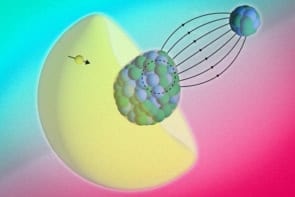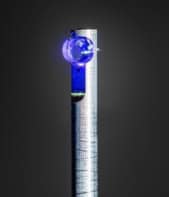Particles called B mesons do not decay at the same rate as their anti-particles, according to the first results from experiments in Japan and the US. But it is not yet clear if the difference is big enough to explain why the universe is dominated by matter. Preliminary results from two high-energy experiments - dubbed 'B factories' because they generate huge numbers of B mesons - have been submitted to Physical Review Letters and are currently available on the Los Alamos preprint server.
The BaBar collaboration at Stanford Linear Accelerator Center in the US and the BELLE collaboration at the KEK laboratory in Japan began collecting data just a year ago, and early results confirm that they have successfully measured differences in the decay rates of B mesons and their anti-particles.
Cosmologists believe that anti-matter and matter – known as baryonic material – were created in equal amounts at the beginning of the universe. It was once thought that particles and their anti-particles had exactly the same mass but opposite electrical charges, and that they produced identical – but mirror image – decay traces.
But anti-matter and matter must have undergone slightly different processes since the Big Bang to account for the dominance of matter over anti-matter that we see today. Experiments in the 1960s supported this idea by showing that particles known as K mesons were not exact opposites of their anti-particles because they decayed at different rates. Russian physicist Andrei Sakharov later proposed a mechanism for this so-called asymmetry, known as charge-parity (CP) violation.
But the unusual behaviour of the K mesons cannot alone account for the excess matter in the universe, and although CP violation is consistent with the tried and tested Standard Model of particle physics, it is not fully proven. The BaBar and BELLE experiments were devised to help fill the gap by searching for asymmetry in decays of the B mesons. Asymmetry effects were expected to be more pronounced in the B mesons than in the lighter K mesons.
The B factories fire a beam of positrons into a beam of electrons to create millions of pairs of B mesons and their anti-particles. Detectors measure the decay rates of B mesons and anti-B mesons extremely accurately, and from this physicists calculate a quantity known as ‘sin 2-beta’. The BaBar experiment found a sin 2-beta value of 0.34 +/- 0.2, which is around twice as accurate as the previous best guess. The BELLE estimate is 0.58 +/- 0.33.
“The new results are very exciting and are strong evidence for CP violation in another system”, Ken Peach, a particle physicist at Rutherford Appleton Laboratory in the UK, told PhysicsWeb. Although these results are too uncertain to decide the fate of the CP violation theory, they strongly support the idea that asymmetry exists in B mesons. The error levels are expected to fall as the BaBar and BELLE teams continue to plough through the huge volumes of data they have collected.
“There is a long way to go before we can tell whether the B meson asymmetry is linked to the excess of baryonic material in the universe”, said Peach. “But this is an extremely important first step – and I very much look forward to the analysis of new data”.



